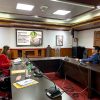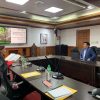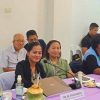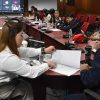ᴅᴏʟᴇ ʙᴜɪʟᴅɪɴɢ, ɪɴᴛʀᴀᴍᴜʀᴏꜱ || ᴊᴜʟʏ 25, 2023
The Department of Labor and Employment (DOLE) has taken action to provide timely financial assistance to rubber farmers and workers impacted by the Pestalotiopsis Leaf Fall Disease (PLFD) crisis. Executive Director Cheryl L. Eusala, together with Undersecretary Atty. Benjo Santos M. Benavidez of the DOLE Workers’ Welfare and Protection Cluster, recently held a meeting where they discussed the Control and Mitigation plan for PLFD, alongside an essential call to action plan.
During the meeting held last July 25 at the DOLE Building, Intramuros, Executive Director Eusala presented the latest status of the PLFD outbreak in rubber plantations, stressing the urgency of finding viable solutions to protect the livelihoods of those affected. With the disease posing a significant threat to rubber plantations nationwide, immediate intervention became necessary to curb its spread and restore the productivity of infected areas.
The highlight of the meeting was the approval of PRRI’s request to integrate DOLE’s TUPAD (Tulong Panghanapbuhay sa Ating Disadvantaged/Displaced Workers) program to provide timely financial assistance to rubber farmers and workers affected by the PLFD crisis, ensuring continuity of livelihoods during treatment and rehabilitation. The integration aims to provide much-needed financial support to rubber farmers and farm workers who have been severely impacted by the PLFD outbreak. The TUPAD program will ensure the continuity of their livelihoods during the critical period of treatment and rehabilitation of infected rubber plantations. Under the approved plan, several key objectives have been laid out to include income augmentation and financial support, and treatment and rehabilitation of infected plantations.
Notably, the TUPAD program’s implementation complements the Quick Response Fund (QRF) and the Pesta Treatment Plan. The QRF provides immediate support for emergency situations, enabling swift action and relief measures. The Pesta Treatment Plan focuses on specific strategies to manage and control the PLFD, aiming to mitigate its destructive effects on rubber plantations. This initiative of PRRI is also a way of supplementing the current available quick response fund and harmonizing programs with other national agencies to better help affected rubber farmers and tappers.
Expressing her satisfaction with DOLE’s acceptance of the proposal, Executive Director Eusala lauded the department’s commitment to addressing the PLFD crisis promptly. She further appreciated DOLE’s proactive approach in offering to extend the program’s benefits to a larger number of beneficiaries, specifically from Regions 9 to 13.
The integration of the TUPAD program into the PLFD Control and Mitigation plan is seen as a significant step in safeguarding the welfare of thousands of rubber farmers and workers whose livelihoods were threatened by the devastating disease outbreak. By combining efforts from different government sectors, this collaborative approach demonstrates the government’s dedication to supporting the agricultural sector and its workers during times of crisis.
As the program takes effect, stakeholders in the rubber industry are hopeful that the timely financial assistance and rehabilitation efforts will not only alleviate the impact of PLFD but also pave the way for a resilient and thriving rubber industry in the Philippines.
-𝐄𝐥𝐥𝐢𝐧𝐞 𝐌. 𝐀𝐡𝐢𝐠






